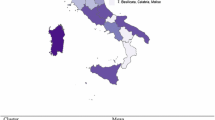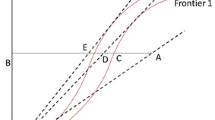Abstract
The fairly recent discovery and growing use of costly, revolutionary biotechnology drugs (e.g., GM-CSFs) in hospitals represent a major technical innovation in clinical pharmacy intervention. This paper models the translog production cost impacts of ten distinct clinical pharmacy tasks including pharmacokinetics, consultations with MDs, monitoring drug interactions,..., and presents results on decomposed technical change, economies of scope, scale economies, total factor productivity, and the alternatively defined pairwise factor substitution possibilities. The model was fitted to 1981–1990 time-series/cross-sectional data of US hospital pharmacies (source: Eli-Lilly Co.®). Zellner's ISURE (Iterative Seemingly Unrelated Regression Equations) system estimates reveal a non-homothetic underlying technology with biased and pure technical change effects dominating scale-augmentation. Certain clinical tasks increase costs but are cost-saving if jointly produced with selective others. One of the largest and statistically significant economies of scope estimates is between ‘monitoring drug interactions’ and ‘consultations with MDs’. Cost implications of findings are given in light of the recent trends in hospital pharmacy clinical activities, related professional health manpower, and piecemeal health policy reforms.
Similar content being viewed by others
References
Adamcik, B. A. et al. (1986). “New Clinical Roles for Pharmacists: A Study of Role Expansion.” Social Science and Medicine 23, 1187–1200.
Adams, J. D. (1999). “The Structure of the Firm R&D, the Factor Intensity of Production, and Skill Bias.” The Review of Economics and Statistics 81, 499–510.
APhA. (1998). The Clinical Reference Library. Washington, DC: American Pharmaceutical Association.
APhA. (1990). “More Research Needed on Pharmacy Cost-Effectiveness.” American Pharmacy NS30(5), 12–13.
Ballington D. A., R. Spires, D. Tapley and C. Bateman. (1990). “Survey of Technician Use in Hospital and Community Pharmacies in S. Carolina.” American Journal of Hospital Pharmacy 47, 2066–2068.
Banker, R. D. and A. Maindiratta. (1986). “Piecewise Loglinear Estimation Method.” Management Science 32, 30–44.
Baumol, W. J., J. C. Panzar and R. D. Willig. (1982). Contestable Markets and the Theory of Industrial Structure. New York: Harcourt Brace Jovanovich.
Betts, J. R. (1997). “The Skill Bias of Technological Change in Canadian Manufacturing Industries.” The Review of Economics and Statistics LXXIX, 146–150.
Blackorby, C. and R. R. Russell. (1989). “Will the Real Elasticity of Substitution Please Stand Up?” The American Economic Review 79, 882–888.
Blackstone, C. and J. P. Fuhr, Jr. (1993). “An Antitrust Analysis of Non-Profit Hospital Mergers.” Review of Industrial Organization 8, 473–490.
Bluml, B. M. (1989). QARx ® for Windows TM Version 5.0. “...Documenting Interventions and Outcomes. Washington, DC: American Pharmaceutical Association.
Bryce, L., J. B. Engberg and D. R. Wholey. (2000). “Comparing the Agreement among Alternative Models in Evaluating HMO Efficiency.” Health Services Research 35, 509–528.
Butler, J. R. G. (1995). Hospital Cost Analysis. Dordrecht: Kluwer Academic Publishers.
Canaday, B. R., ed. (1994). OBRA'90: A Practical Guide to Effecting Pharmaceutical Care. Washington, DC: The American Pharmaceutical Association.
Chalfant, J. A. and A. R. Gallant. (1985). “Estimating Substitution Elasticities with the Fourier Cost Function--Some Monte Carlo Results.” Journal of Econometrics 28, 205–222.
Charnes, A., W. W. Cooper and E. L. Rhodes. (1978). “Measuring the Efficiency of Decision Making Units.” European Journal of Operations Research 2, 429–444.
Chirikos, T. N. (1998/99). “Further Evidence that Hospital Production is Inefficient.” Inquiry 35, 408–416.
Christensen, L. R., D. W. Jorgenson and L. J. Lau. (1973). “Transcendental Logarithmic Production Frontiers.” The Review of Economics and Statistics 55, 28–45.
Cooper, R. A., P. Laud and C. L. Dietrich. (1999). “Current and Projected Workforce of Nonphysician Clinicians.” Journal of the American Medical Association 280, 788–794.
Cooper, W. W. and C. A. K. Lovell. (2000). “New Approaches to Measures of Efficiency in DEA: An Introduction.” Journal of Productivity Analysis 13, 91–92.
Cowing, T. G. and A. G. Holtmann. (1993). “Multiproduct Short-Run Hospital Cost Functions: Empirical Evidence and Policy Implications from Cross-Sectional Data.” Southern Economic Journal 49, 637–653.
Cox, E. R. and C. E. Reeder (1994). “Estimation of Internal Rate of Return to the Two Year Post-BS PharmD Degree.” American Journal of Pharmaceutical Education 58, 1–7.
Eng, H. J. (1987). “Pharmacist as Prescriber.” Journal of Clinical Pharmacy & Therapeutics 12, 237–242.
Feldstein, P. J. (1999). Health Care Economics. 5th Edition. Boston, MA: Delmar Publishers.
Fisher, J. and D. Pathak. (1980). “Influence of Attitudes, Normative Beliefs and Situational Variables on Physicians' Use of Pharmacists as Drug Information Consultants.” American Journal of Hospital Pharmacy 37, 183–191.
Flohrs, W. J., (ed). (1990 and earlier). Lilly Hospital Pharmacy Survey. Annual Reports. Indianapolis, IN: Eli Lilly & Co. Pharmaceutical Division, Lilly Corporate Center.
Fournier, G. M. and J. M. Mitchell. (1992). “Hospital Costs and Competition for Services: A Multiproduct Analysis.” The Review of Economics and Statistics 74, 627–634.
Gagne, R. and P. Ouellette. (1998). “On the Choice of Functional Forms: Summary of a Monte Carlo Experiment.” Journal of Business & Economic Statistics 16, 118–124.
Gannon, K. (1997). “Clinical Pharmacy Services Deliver Solid Cost Benefit.” Hospital Pharmacist Report 11, 22.
Garrelts J. C. and D. Smith, Jr. (1990). “Clinical Services Provided by Staff Pharmacists in a Community Hospital.” American Journal of Hospital Pharmacy 47, 2011–2015.
Giannakas, K., K. C. Tran and V. Tzouvelekas. (2000). “Efficiency, Technological Change and Output Growth in Greek Olive Growing Farms: A Box-Cox Approach.” Applied Economics 32, 909–916.
Given, R. (1996). “Economies of Scale and Scope as an Explanation of Merger and Output Diversification Activities in the Health Maintenance Organization Industry.” Journal of Health Economics 15, 685–714.
Guerrero, R. M., N. A. Nickman and J. N. Blair. (1990). “Using Pharmacists' Perceptions in Planning Changes in Pharmacy Practice.” American Journal of Hospital Pharmacy 47, 2026–2030.
Health Care Financing Administration. (1990). Health Care Financing Review 12, 5–7.
Hepler, C. D. and L. M. Strand. (1990). “Opportunities and Responsibilities in Pharmaceutical Care.” American Journal of Hospital Pharmacy 47, 533–543.
Hollingsworth, B., P. Dawson and N. Maniadakis. (1999). “Efficiency Measurement of Health Care: A Review of Non-parametric Methods and Applications.” Health Care Management Science 2, 161–172.
Hornbrook, M. C. and A. C. Monkeit. (1985). “The Contribution of Case-Mix Severity to the Hospital Cost-Output Relation.” Inquiry 22, 259–271.
Keeler, T. E. and J. S. Ying. (1996). “Hospital Costs and Excess Bed Capacity: A Statistical Analysis.” The Review of Economics and Statistics 58, 470–481.
Kershaw B. P., B. J. Zarrowitz, D. K. Solomon et al. (1989). “The Evaluation of Pharmacist-Technician Teams Applied to a Satellite Pharmacy.” Hospital Pharmacy 24, 9-11 and 15–23.
Kirking, D. (1984). “Evaluation of an Explanatory Model of Pharmacists' Patient Counseling activities.” Journal of Social and Administrative Pharmacy 3, 50–56.
Kleinke, J. D. (2000). “Just What the HMO Ordered: The Paradox of Increasing Drug Costs.” Health Affairs 19, 78–91.
Koizumi, T. (1976). “A Further Note on Definition of Elasticity of Substitution in the Many Input Case.” Metroeconomics 28, 152–155.
Leape, L. L. et al. (1999). “Pharmacist Participation on Physician Rounds and Adverse Drug Events in the Intensive Care Unit.” Journal of the American Medical Association 282, 267–270.
Lichtenberg, F. R. (1996). “Do (More and Better) Drugs Keep People Out of Hospitals?” The American Economic Review, Papers and Proceedings 86, 384–388.
Linna, M. (2000). “Health Care Financing Reform and the Productivity Change in Finnish Hospitals.” Journal of Health Care Finance 26, 83–100.
Martin, S. (1992). “Uniting for One Pharmacy Degree: Advocating a New Doctor of Pharmacy Degree. APhA, ASHP, and NARD Move to End the “BS vs. PharmD” Debate.” American Pharmacy NS32, 52–55.
McFadden, D. (1963). “Constant Elasticity of Substitution Production Functions.” Review of Economic Studies 30, 73–83.
Mensah, Y. M. and L. She-Hsing. (1993). Measuring Production Efficiency in a Not-for-Profit Setting: An Extension.” The Accounting Review 68, 66–88.
Montazeri, M. and D. J. Cook. (1994). “Impact of a Clinical Pharmacist in a Multidisciplinary Intensive Care Unit.” Critical Care Medicine 22, 1044–1048.
Morey, R. C., D. L. Retzlaff-Roberts, D. J. Fine and S. W. Loree. (2000). “Assessing the Operating Efficiencies of Teaching Hospitals by an Enhancement of the AHA/AAMC Method.” Academic Medicine 75, 28–40.
Mucklo, M. (2000). “Health Care Costs 2001.” In Medical Benefits. New York: Panel Publishers, 1–2.
Mundlak, Y. (1978). “Elasticities of Substitution and the Theory of Derived Demand.” Review of Economic Studies 35, 225–236.
Nightengale, B. S. (1994). “Pharmacoeconomic Applications in Nuclear Medicine: Cost-Effectiveness of TI-201 vs Tc99m-sestamibil. Paper presented at the 141st American Pharmaceutical Asssociation annual Meetings, Seattle, WA, March 19–23.
Ohta, M. (1974). “A Note on the Duality between Production and Cost Functions: Rate of Returns to Scale and Rate of Technical Progress.” Economic Studies Quarterly 25, 63–65.
Okunade, A. A. (1999). “Will the Real Elasticity of Substitution ‘in Norwegian Dentistry’ Please Stand Up?” Health Economics 8, 221–232.
Okunade, A. A. (1991). “Translog Cost Estimates of Labor-Labor Substitution in US Hospital Pharmacies.” Journal of Research in Pharmaceutical Economics 3, 91–113.
Schumann, W. and J. B. V. Linde. (1997). Pharmacy Certified Technician Training Manual, 7th Edition. Washington, DC: The American Pharmaceutical Association.
Segerson, K. and S. Ray. (1989). “On the Equivalence of Alternative Measures of Elasticity of Substitution.” Bulletin of Economic Research 14, 207–212.
Shepard III, E. M., T. J. Clifton and D. Kruse. (1996). “Flexible Work Hours and Productivity: Some Evidence from the Pharmaceutical Industry.” Industrial Relations 35, 123–139.
Thompson, P. and T. G. Taylor. (1997). “The Capital-Energy Substitutability Debate: A New Look.” The Review of Economics and Statistics LXXVII, 565–569.
US Department of Health and Human Services, Public Health Service. (1994). FDA Medical Bulletin FDA (HFI-42), MEDWATCH Section, 24.
Vita, M. G. (1990). “Exploring Hospital Cost Functions with Flexible Functional Forms.” Journal of Health Economics 9, 1–21.
Wilks, S. S. (1938). “The Large Sample Distribution of the Likelihood Ratio for Testing Composite Hypothesis.” Annals of Mathematical Statistics 9, 60–62.
Wholey, D. R., R. Padman, R. Hamer and S. Schwartz. (2000). “The Diffusion of Information Technology among Health Maintenance Organizations.” Health Care Management Review 25, 24–33.
Zellner, A. J. (1962). “An Efficient Method for Estimating Seemingly Unrelated Regressions and Tests for Aggregation Bias.” Journal of The American Statistical Association 57, 585–612.
Author information
Authors and Affiliations
Rights and permissions
About this article
Cite this article
Okunade, A.A. Cost-Output Relation, Technological Progress, and Clinical Activity Mix of US Hospital Pharmacies. Journal of Productivity Analysis 16, 167–193 (2001). https://doi.org/10.1023/A:1011635411864
Issue Date:
DOI: https://doi.org/10.1023/A:1011635411864




